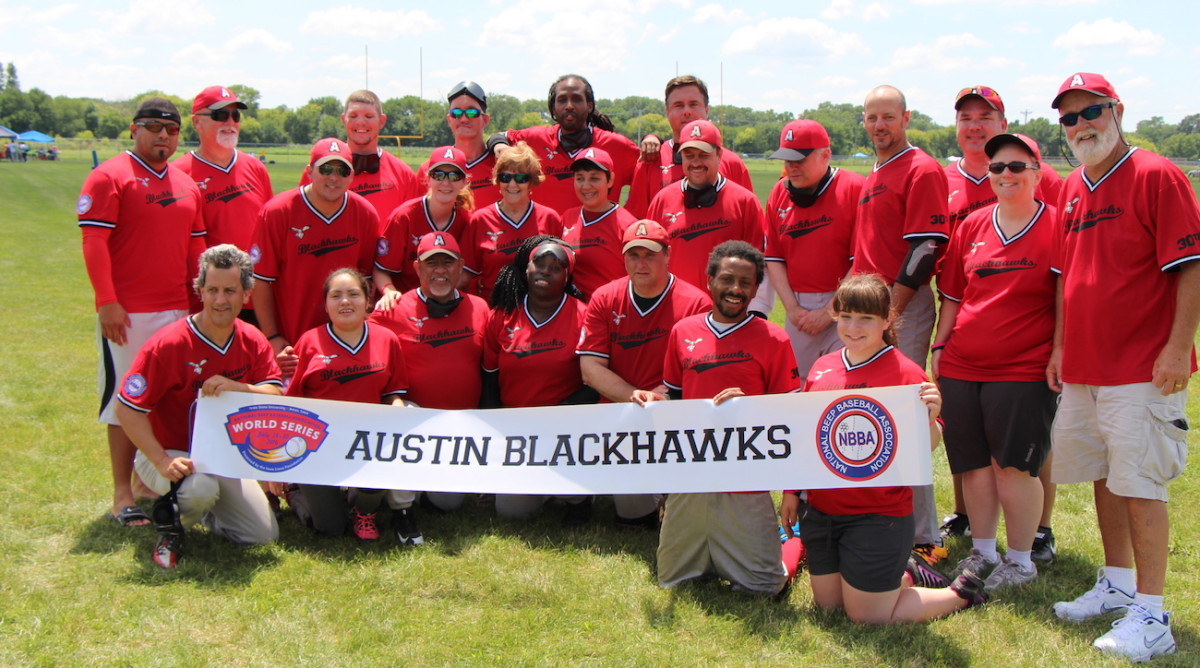Beep Baseball Provides Opportunities for Visually Impaired Athletes

It’s a hot July day in Central Texas. The Austin Blackhawks are on the field excitedly warming up for the practice ahead. Head coach Jonathan Fleming sets up bases and other equipment needed for the rigorous training session. Soon the sound of beeping, buzzing, and hitting are heard on the field. That’s because the Blackhawks play beep ball, an adaptive sport similar to baseball for the blind and visually impaired.
To understand the sport, and how it came to be, let’s go back to 1964. It was then that Charley Fairbanks, a telephone worker, created the first beep ball. Eleven years later, a newly designed beep ball was made, and that same year John Ross, the director of the Braille Sports Foundation, and Dennis Huberty, organizer of the experimental team from St. Paul, wrote the first set of rules for the updated game.
Teams began to pop up all over the country. Among them were the Austin Blackhawks, who recently celebrated their 31st season in the National Beep Ball League. Unlike with other professional sports, there are no divisions, just one league that every beep ball team across the world is a part of. The Blackhawks are now the winningest team, having taken home nine championships. The Blackhawks are also the longest standing consecutive-season team in the NBBA.
The rules of beep ball are quite a bit different from the rules of traditional baseball. To start, the pitcher and the batter are on the same team. The pitcher is sighted and gives these commands: “Set, ready, ball!” Once the batter makes contact, he or she must sprint to one of two bases; the traditional first or traditional third.
The bases buzz, so once the batter identifies which of the two is buzzing, he or she takes off for it before tackling the base like a football player. If the batter reaches the base before one of the six fielders picks up the beeping ball, the batter is safe and scores a run for his or her team. If the opposite occurs, it is counted as an out.
The equipment also varies from baseball. Although a bat, ball, and bases are all used, they come in different shapes and sizes. The ball is much heavier and larger, and instead of a cap, the players don blindfolds. (This levels the playing field because some players have limited sight and others are completely blind.) There are also only two bases, and no gloves are used. However, diving, sliding, and blocking to stop the ball are the best ways to field it!

“It’s helped me to be able to play sports again and reunite with the game of baseball,” said Brandon Chesser, a 10-year veteran who recorded the final out of the 2014 Beep Ball World Series. He’s just one of many whose lives have been changed through beep ball and the athletic opportunities it provides.
One of the experiences the Blackhawks have had was taking an international trip to the Dominican Republic during which they got to play an exhibition against the Caribbean Hurricanes (the beep ball team from the D.R.) in a game with a turnout of 4,000 people in a pro stadium!
“I’ve played so many different sports in many different places, but nothing compares to playing [in the Dominican Republic] in front of 4,000 screaming fans,” Chesser said with a smile.
Another longtime player, Mariano Reynoso, added, “The experience was pretty unreal! We got to meet the vice president of the Dominican Republic, were in a TV show, and also met major league greats Pedro Martinez, Moises Alou, and Octavio Dotel!”
In addition to playing exhibitions, the team also plays tournaments. The biggest tournament of the year is the World Series, which was held this year in West Palm Beach, Florida. (The Indy Thunder won, and the Blackhawks came in eighth.) “My favorite part is the competitiveness,” said Chesser.
“I really enjoy being around the guys,” said Tim Hibner, a pitcher who commutes from Oklahoma each month and has been around the sport since 1982.
I enjoyed being around the players as well. I got to hear their backgrounds and stories. My favorite—and most embarrassing—part was when I got to put on a blindfold and hit, run, and field! Hibner pitched to me and Coach Fleming helped me field. Although I did O.K., I came away with tremendous respect for the players. It is hard! Timing and confidence are two skills that are extremely important in beep ball.
The players are true sports champions because despite having limited or no sight, they have positive attitudes, trust each other, and try hard. They persevere, and that is what makes the sport so inspirational and enjoyable to watch.
Photographs courtesy of Marge Bancroft
